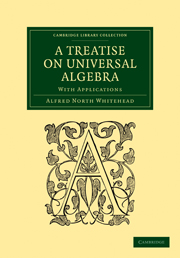Book contents
- Frontmatter
- PREFACE
- Contents
- BOOK I PRINCIPLES OF ALGEBRAIC SYMBOLISM
- BOOK II THE ALGEBRA OF SYMBOLIC LOGIC
- BOOK III POSITIONAL MANIFOLDS
- BOOK IV CALCULUS OF EXTENSION
- BOOK V EXTENSIVE MANIFOLDS OF THREE DIMENSIONS
- CHAPTER I SYSTEMS OF FORCES
- CHAPTER II GROUPS OF SYSTEMS OF FORCES
- CHAPTER III INVARIANTS OF GROUPS
- CHAPTER IV MATRICES AND FORCES
- BOOK VI THEORY OF METRICS
- BOOK VII APPLICATION OF THE CALCULUS OF EXTENSION TO GEOMETRY
- Index
CHAPTER II - GROUPS OF SYSTEMS OF FORCES
Published online by Cambridge University Press: 29 August 2010
- Frontmatter
- PREFACE
- Contents
- BOOK I PRINCIPLES OF ALGEBRAIC SYMBOLISM
- BOOK II THE ALGEBRA OF SYMBOLIC LOGIC
- BOOK III POSITIONAL MANIFOLDS
- BOOK IV CALCULUS OF EXTENSION
- BOOK V EXTENSIVE MANIFOLDS OF THREE DIMENSIONS
- CHAPTER I SYSTEMS OF FORCES
- CHAPTER II GROUPS OF SYSTEMS OF FORCES
- CHAPTER III INVARIANTS OF GROUPS
- CHAPTER IV MATRICES AND FORCES
- BOOK VI THEORY OF METRICS
- BOOK VII APPLICATION OF THE CALCULUS OF EXTENSION TO GEOMETRY
- Index
Summary
Specifications Ofa Group. (1) If S1, S2, … S6 be any six independent [cf. § 96 (2)] systems of forces, then any system can be written in the form λ1S1+λ2S2+ … λ6S6. Let λ1, λ2, … λ6 be called the co-ordinates of S as referred to the six systems.
Definitions. The assemblage of systems, found from the expression λ1S1+λ2S2 by giving the ratio λ1: λ2 all possible values, will be called a ‘dual group’ of systems. The assemblage of systems, found from the expression λ1S1+λ2S2+ λ3S3 by giving the ratios λ1: λ2: λ3 all possible values, will be called a ‘triple group’ of systems.
The assemblage, found from λ1S1+λ2S2+ λ3S3 + λ4S4 by giving the ratios λ1: λ2: λ3: λ4 all possible values, will be called a ‘quadruple group.’ The assemblage, found from λ1S1+λ2S2+ λ3S3 + λ4S4 + λ5S5 by giving the ratiosλ1: λ2: λ3: λ4: λ5 all possible values, will be called a ‘quintuple group’
(2) A dual group will be said to be of one dimension, a triple group of two dimensions, and so on.
It is obvious that a group of ρ - 1 dimensions (ρ = 2, 3, 4, 5) can be defined by any ρ independent systems belonging to it; and also that not more than ρ independent systems can be found belonging to it.
- Type
- Chapter
- Information
- A Treatise on Universal AlgebraWith Applications, pp. 284 - 299Publisher: Cambridge University PressPrint publication year: 2009First published in: 1898



